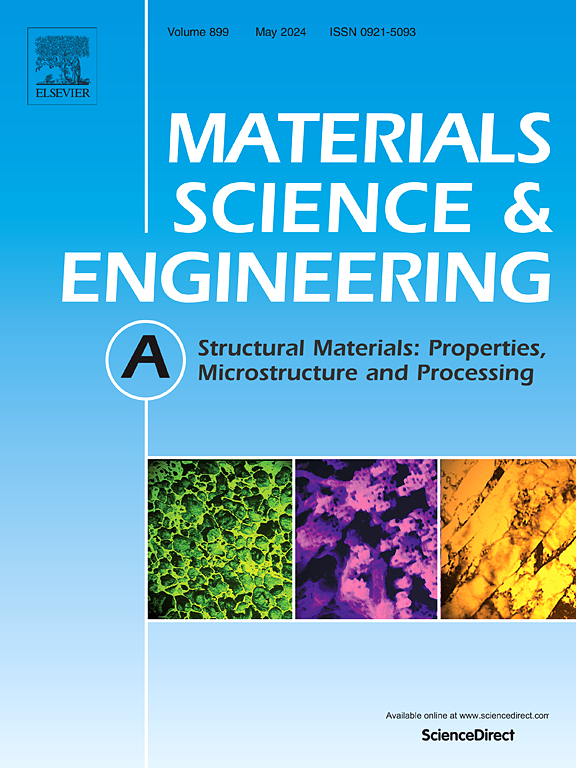异种超高强度钢的定向能沉积修复:马氏体变体选择与动态变形机制
IF 6.1
2区 材料科学
Q1 MATERIALS SCIENCE, MULTIDISCIPLINARY
引用次数: 0
摘要
激光定向能沉积(DED)技术用于超高强度钢(UHSS)部件局部损伤后异种材料增强修复是一种经济有效的修复方法,可显著提高部件的性能。本研究采用高合金超高ss AerMet100对30CrMnSi钢进行DED修复,系统评价修复试样的显微组织、准静态力学性能和动态力学性能。目的是在没有后热处理的情况下恢复基材的性能。结果表明:修复区组织以全马氏体组织为主,不含碳化物;由于晶粒细化和碳化物析出增加,在各种力学试验中,30CrMnSi衬底的热影响区没有出现力学性能减弱或退化的迹象。修复试样的极限抗拉强度为965 MPa,相当于基体强度(970 MPa)的99%。此外,修复区板条马氏体对V7 ~ V12表现出强烈的变异偏好,而在同一习惯面内的6种变异几乎分布均匀,说明马氏体的变异偏好转变主要受亲本奥氏体特定习惯面控制,而非习惯方向。此外,位错滑移倾向于遵循较长的路径以避免板条边界的过早阻塞,再加上体心立方结构中可用滑移系统的数量较多,使得马氏体的形状因子成为高应变速率变形下滑移系统激活的关键决定因素。本文章由计算机程序翻译,如有差异,请以英文原文为准。
Directed energy deposition repair of dissimilar ultra-high strength steels: Martensite variant selection and dynamic deformation mechanism
Laser directed energy deposition (DED) for dissimilar material reinforcement repair of ultra-high strength steel (UHSS) components after localized damage is a cost-effective method that significantly improves the performance of the components. In this study, high-alloy UHSS AerMet100 was used for DED repair on 30CrMnSi steel, and the microstructure, as well as the quasi-static and dynamic mechanical properties of the repaired samples, were systematically evaluated. The aim is to achieve restoration of base material properties without post-heat treatment. The results indicate that the microstructure of the repair zone is predominantly composed of fully martensitic, devoid of carbides. Owing to grain refinement and increased carbide precipitation, the heat affected zone of the 30CrMnSi substrate showed no signs of weakening or degradation in mechanical properties in various mechanical tests. The ultimate tensile strength of the repaired sample is 965 MPa, which corresponds to 99 % of the substrate strength (970 MPa). Additionally, the lath martensite in the repair zone exhibited a strong variant preference for V7 to V12, while the six variants within the same habit plane were nearly evenly distributed, indicating that martensite variant preferential transformation is primarily governed by the specific habit plane of the parent austenite, rather than the habit direction. Moreover, the tendency of dislocation slip to follow longer paths to avoid premature obstruction at lath boundaries, combined with the greater number of available slip systems in the body-centered cubic structure, makes the shape factor of martensite the key determinant in slip system activation under high strain rate deformation.
求助全文
通过发布文献求助,成功后即可免费获取论文全文。
去求助
来源期刊

Materials Science and Engineering: A
工程技术-材料科学:综合
CiteScore
11.50
自引率
15.60%
发文量
1811
审稿时长
31 days
期刊介绍:
Materials Science and Engineering A provides an international medium for the publication of theoretical and experimental studies related to the load-bearing capacity of materials as influenced by their basic properties, processing history, microstructure and operating environment. Appropriate submissions to Materials Science and Engineering A should include scientific and/or engineering factors which affect the microstructure - strength relationships of materials and report the changes to mechanical behavior.
 求助内容:
求助内容: 应助结果提醒方式:
应助结果提醒方式:


